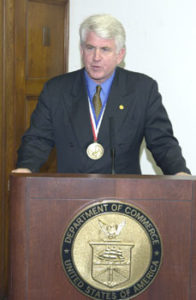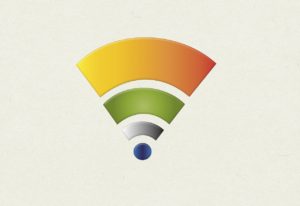It’s only within the last few years that Wi-Fi has become virtually ubiquitous, but did you know that the history of Wi-Fi reaches back more than 45 years? Read on to learn more about the timeline of this amazing technology that powers the contemporary world.
1971—The precursor to the Wi-Fi we know today makes its first appearance in a surprising place: Hawaii. Using a technology called UHF, or ultra-high-frequency radio waves, a team of computer scientists at the University of Hawaii complete the first-ever wireless data packet transfer without the need for connected cables or a satellite. The resulting connected network, which comprises seven computers on four different Hawaiian islands, is known as ALOHAnet.

Image courtesy Wikipedia
1973—Robert Metcalfe of California’s Xerox Palo Alto Research Center writes the first proposal for a universal standard for interconnecting computers, rather than a host of different proprietary solutions. This concept will underlie future development of a similar standard for wireless technology.
1985—Up to this point in history, the Federal Communications Commission (FCC) has regulated nearly all telecommunications in the US. But in 1985, in response to promptings from industry, the FCC makes the unprecedented move of opening up three bands of the wireless spectrum—900 MHZ, 2.4 GHz, and 5.8 GHz—allowing people to use them for communications purposes without a government license (the specifications for this technology are known as 802.11). Companies like IBM and AT&T quickly jump into creating their own wireless local area networks (LANs) in the late 1980s, laying the foundation for the Wi-Fi we know today.
1990—Vic Hayes, who will eventually become known as the “Father of Wi-Fi,” founds the IEEE 802.11 Working Group for Wireless LANs. The aim of the group is to develop regulatory protocols that will help allow for widespread, efficient use of wireless technology.
1993—At the NetWorld+Interop conference in San Francisco, Henrik Sjödin suggests an idea for public or open access wireless LANs. This is the first mention of the concept that will later become known as a “Wi-Fi hotspot.” Later this same year, a large-scale deployment of AT&T’s LAN, called WaveLAN, is rolled out at Carnegie Mellon University. This experiment is one of the first major tests of the potential of wireless LANs on a bigger scale.
1994—The development of large-scale wireless LAN projects continues with “Wireless Andrew,” a wireless research initiative conducted by Carnegie Mellon’s Dr. Alex Hills and funded by the National Science Foundation. “Wireless Andrew” provides wireless coverage to seven different buildings on the Carnegie Mellon campus.
1996—A technique for limiting the degree of multipath interference that radio signals encounter when they are transmitted for computer networking is patented by the Commonwealth Scientific and Industrial Research Organization (CSIRO) of Australia. Developed by John O’Sullivan, this technique will form an integral part of the 802.11a wireless standards (as well as later versions).
1997—The original version of the 802.11 protocol is released. Link speeds at this time are 2 megabits per second, a fraction of today’s speeds.
1998— Mark Goode and Greg Jackson found the wireless Internet service provider MobileStar. Not only does Goode coin the term “hotspot,” but his company goes on to become the first provider of these new “Wi-Fi hotspots” to businesses like Starbucks, American Airlines, and Hilton Hotels.
 1999—Vic Hayes and the IEEE update the Wi-Fi standard from 802.11a to 802.11b. Allowing link speeds of 11 megabits per second on the 2.4 GHz radio frequency, this update essentially expands the scope of wireless technology and brings it into the homes and offices of everyday consumers. Seeking a more user-friendly name than “IEEE 802.11b,” the IEEE committee brings in a branding firm to rename the technology: “Wi-Fi” is the result.
1999—Vic Hayes and the IEEE update the Wi-Fi standard from 802.11a to 802.11b. Allowing link speeds of 11 megabits per second on the 2.4 GHz radio frequency, this update essentially expands the scope of wireless technology and brings it into the homes and offices of everyday consumers. Seeking a more user-friendly name than “IEEE 802.11b,” the IEEE committee brings in a branding firm to rename the technology: “Wi-Fi” is the result.
This same year, in response to the growing need for universal compatibility and a quality user experience, the nonprofit trade association called the Wi-Fi Alliance forms. The organization operates the Wi-Fi trademark and helps ensure interoperability through its certification process.
2000 – 2005—The Wi-Fi 802.11 protocol versions continue to be updated as new technology becomes available. In 2003, the World Radio Conference allows wireless devices to access an additional 455 MHz of radio spectrum in the 5 GHz area. By 2005, global sales and shipments of Wi-Fi chipsets, or Wi-Fi-connected devices, are topping 100 million annually.
2009—Total Wi-Fi chipset sales break the 1 billion threshold.
2010—There are now more than 1 million different Wi-Fi hotspots around the world. This same year, in response to a proposed National Broadband Plan from the FCC, US President Barack Obama signs a memorandum permitting the release of 500 additional MHz of spectrum for the wireless industry.
2015—The number of global Wi-Fi hotspots tops 70 million. And Afghan Wireless Communications Company launches its Super Wi-Fi service in Kabul!

